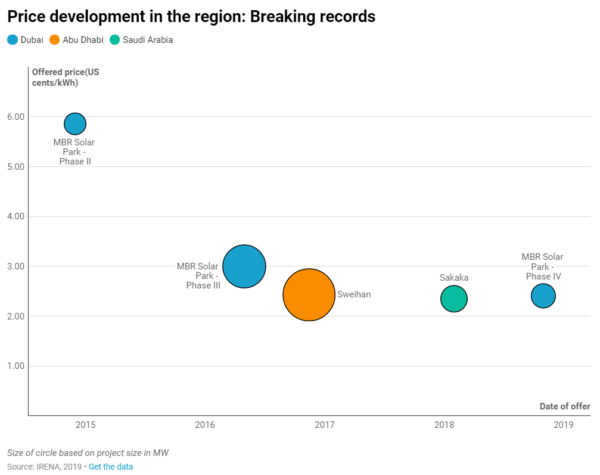The oil-rich nations that make up the Gulf Cooperation Council are racing to get more solar generation capacity into the development pipeline.
Having just commissioned the 1.18 GW Noor Abu Dhabi project – believed to be the largest single PV facility in the world – the Emirates Water and Electricity Company of Abu Dhabi is expecting to receive bids for its next, huge 1.5 GW solar park next month. The emirati utility is also considering including large scale battery storage in the ambitious project.
Dubai, one of the leading renewables developers in the Gulf, is advancing plans for the fifth stage of the sprawling Mohammed bin Rashid Al Maktoum Solar Park. The latest phase comprises 900 MW more solar and major global players including Jinko Power, Engie, ACWA Power, Marubeni and a consortium effort by Masdar and EDF are among the developers lining up to submit offers next month.
New entrants
Within this fast-growing market, other Gulf nations are finally coming on board. Qatari utility Kahramaa has received offers for its 800 MW tender and the official contract award is expected by the end of the month. The Kuwait National Petroleum Company has received engineering, procurement and construction bids for an enormous new 1.25 GW project. The two facilities will be the first of their size in Qatar and Kuwait, possibly signaling the first shift of focus in the power sector away from fossil fuels.
Having dragged its heels in the past, even the world’s second largest oil producer appears to be starting to take renewables seriously. After reaching competitive prices on its Skaka project, the Renewable Energy Project Development Office of Saudi Arabia is tendering six new projects spread around the kingdom with a total generation capacity of 1.5 GW. Oman, meanwhile, is continuing bold plans to tender a further 1.1 GW in two developments.
Analysts are closely monitoring the results of that raft of tenders as the region has traditionally delivered world record low prices for solar power. The new wave of tenders is expected to be no exception, given the size of the projects will boost economies of scale just as technological advancements including the use of bifacial modules enhance yields.

Graphic: Amjad Khashman for pv magazine
While skepticism abounds, given the attempt by Saudi to water down the commitments made at the UN’s last COP climate change gathering in December, the petrostates of the Gulf appear to be introducing renewables into their energy mix.
The UAE was a pioneer, with the futuristic vision of the leadership role that could be played by Dubai and Abu Dhabi in the energy transition. The Dubai Clean Energy Strategy 2050 envisages 7% of the emirate’s power generation coming from clean energy next year and that target rises to 25% by 2030 and 75% by 2050. What started as a vision to pioneer sustainable technology was supported by the economic case offered by PV projects in the region. An abundance of solar irradiation, ever cheaper modules and a preferred investment environment all drove record low PV electricity prices.
Popular content
Winds (and solar) of change
The all-too-obvious need of Gulf states to diversify their economies away from fossil fuels only enhanced the case for solar in the region.
However, the regional PV market is not without challenges. Oman and Saudi may have loosened ownership requirements to attract overseas developers but their neighbors still insist on local entities owning majority stakes in renewables projects.
The Gulf market is only accessible to big international players with sturdy balance sheets, access to cheap finance and the ability to fulfill strict qualification criteria.
The sheer scale of projects tendered ensures lower capital and operations and maintenance costs but solar technology still has to withstand harsh weather conditions, with the extreme soiling and temperature challenges they bring.
For those that can take the heat, however, the rewards can be immense.
By Amjad Khashman
This content is protected by copyright and may not be reused. If you want to cooperate with us and would like to reuse some of our content, please contact: editors@pv-magazine.com.


3 comments
By submitting this form you agree to pv magazine using your data for the purposes of publishing your comment.
Your personal data will only be disclosed or otherwise transmitted to third parties for the purposes of spam filtering or if this is necessary for technical maintenance of the website. Any other transfer to third parties will not take place unless this is justified on the basis of applicable data protection regulations or if pv magazine is legally obliged to do so.
You may revoke this consent at any time with effect for the future, in which case your personal data will be deleted immediately. Otherwise, your data will be deleted if pv magazine has processed your request or the purpose of data storage is fulfilled.
Further information on data privacy can be found in our Data Protection Policy.